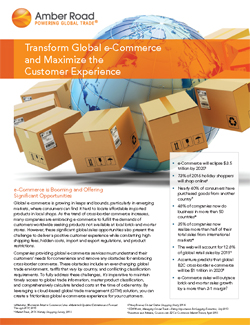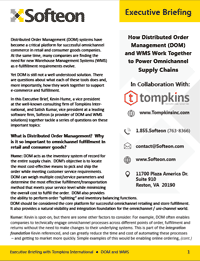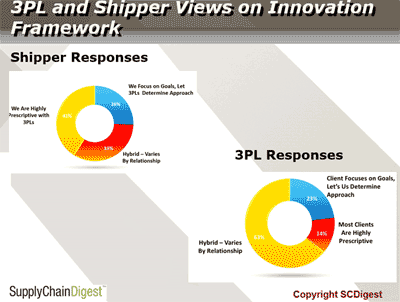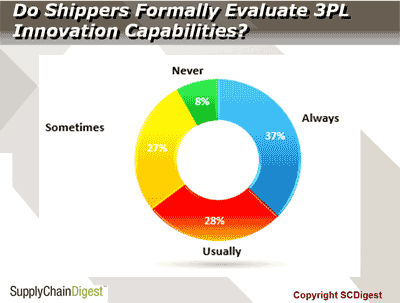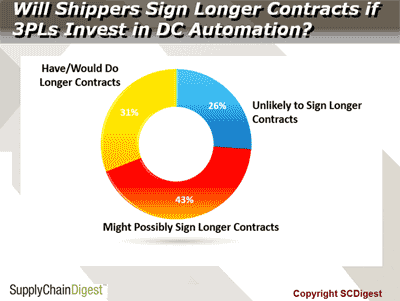 |
April 27, 2017 - Supply Chain Flagship Newsletter |
 |
| FEATURED SPONSOR: AMBER ROAD |
||
 |
|
||||||||||||||||||||||||||||||||||||||||||||||||||||||||||||||||||||||||||||||||||||||||||||||||||||||||||||||||||||||
|
|||||||||||||||||||||||||||||||||||||||||||||||||||||||||||||||||||||||||||||||||||||||||||||||||||||||||||||||||||||||
But then there was some disconnect. 41% of shippers say they are highly prescriptive in their 3PL relationships, while only 14% of 3PLs said most shipper clients are highly prescriptive. I do not how to explain that dichotomy. The right answer should probably be the third choice, a hybrid approach that varies with application and specific 3PL. Commenting on this topic, one shipper said that "We currently are prescriptive but want to focus only on just the goals. However the 3PL are not showing they are capable of using that best approach." Meanwhile, one 3PL noted that "Fulfillment and distribution are pretty much prescribed - "Get it out the door accurately and fast." Logistics and transportation management are more open to innovative approaches driven by us." Interesting. Next, shippers and 3PLs both agree there is a clear trend towards shippers more formally evaluating a logistics services provider's innovation capabilities as part of the selection process. As seen in the chart below, 65% of shippers say they either always or usually do such a formal evaluation, a trend echoed on the 3PL side. I think there numbers are likely much higher than they would have been a decade ago or maybe even 5 years ago. |
|||||||||||||||||||||||||||||||||||||||||||||||||||||||||||||||||||||||||||||||||||||||||||||||||||||||||||||||||||||||
One shipper noted the challenge, saying "We do not yet have a strategy but will develop one as we have some upcoming contracts." Some shippers said they check innovation with the 3PL references, while others said they ask 3PLs to present innovation case studies as part of the selection process. Another added this thoughtful response: "[We] ask for a demonstration of recent innovation and data to support that it is an actual improvement projected savings.You also need to correct for market forces that may inflate or deflate the claimed savings." Finally for this week, a long-running issue is that 3PLs are generally reluctant - to put it mildly - to invest in distribution center automation (often a form of innovation) because contact periods are too short to ensure a payback. It is impossible to invest in a system with a 4-5 year payback when the length of the contract with a shipper is two years. If 3PLs were more willing to make such investments, would shippers be willing to extend contractual periods? (Or should I ask that the other way around?) As seen in the chart below, 31% of shippers said they have and/or would sign longer contracts. 26% say they would not consider such a trade-off, while 41% said they would consider doing so. |
|||||||||||||||||||||||||||||||||||||||||||||||||||||||||||||||||||||||||||||||||||||||||||||||||||||||||||||||||||||||
So there you have it. I keep coming back to the central point that contractual issues - often a reflection of the type of relationship a company wants to have with a 3PL, are huge barriers to innovation, at many levels. As we noted in part 1 of this series, a surprisingly low percentage of shippers and 3PLs are using gainsharing or "vested outsourcing" types of arrangements, without which it makes it tough for the 3PsL to innovate to reduce costs - and hence often revenue. I've just scratched the surface of the data here. Whether you are a shipper, 3PL, or other, there is some great data and insight in the formal benchmark report or the full survey response data. |
|||||||||||||||||||||||||||||||||||||||||||||||||||||||||||||||||||||||||||||||||||||||||||||||||||||||||||||||||||||||
|
|||||||||||||||||||||||||||||||||||||||||||||||||||||||||||||||||||||||||||||||||||||||||||||||||||||||||||||||||||||||
|
|||||||||||||||||||||||||||||||||||||||||||||||||||||||||||||||||||||||||||||||||||||||||||||||||||||||||||||||||||||||
|
|
|
YOUR FEEDBACK
We always get number of brief notes after our video coverage of event like ProMat thanking us for the effort, and we admittedly love to hear that.
You'll find a smattering of those below, including a very nice note from our good friend John Hill, and an interesting letter from someone with direct experience using carton lift assist systems in the DC.
Feedback on SCDigest ProMat 2017 Coverage
![]()
Dan and Cliff:
Kudos for your PROMAT 2017 two-day video review. With roughly 900 exhibitors, thousands of feet to travel and traffic at our own booth that made it difficult to take a break, spending half an hour watching and listening to your recap in the comfort of my office was well worth the time!
John M. Hill
St. Onge Company
![]()
I appreciate your Weekly Reviews and your recent summaries from ProMat.
You mentioned that you hadn't really seen much use of vacuum assist technology out there, other than in some heavy manufacturing environments. Just wanted to let you know that I work for a distributor in the Midwest, and we have been using vacuum assist in our warehouse for a couple years now.
Our primary application is unloading ocean containers that are stacked floor to ceiling with cartons that would be categorized as mildly heavy (5-30 lbs). But it is definitely tiring work, since the cartons are not on pallets and can't be removed that way. So we use a vacuum assist unit attached to a belt conveyor that can be extended into the container as it is worked. The cartons are then pulled off the conveyor and stacked on pallets by SKU.
It has been a success, and has eliminated a lot of back-breaking (or at least back-tiring) work.
Jeff Rech

![]()
Fantastic job as usual summarizing trends and solutions at ProMat.
Your video summaries are outstanding, and should be "must watch" for logistics professionals.
Don't know how you do it so well so fast. Keep it up!
Mike Bucher
Columbus, IN
![]()
Great video coverage for all of us that could not make the conference.
Garth Hiles
Director, Supply Chain Logistics
Save On Foods

SUPPLY CHAIN TRIVIA ANSWER
Q: In 1979, business man and author Philip Crosby released what seminal book regarding manufacturing processes?
A: Quality is Free.
| © SupplyChainDigest™ 2003-2017. All Rights Reserved. SupplyChainDigest PO Box 714 Springboro, Ohio 45066 |
POWERED BY: XDIMENSION
|




